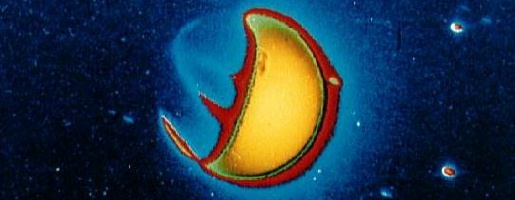 |
||
|
This Apollo 16 ultraviolet view of Earth shows the
faint blue auroral emission as the solar wind streams around the planet.
|
||
| SOLAR WIND | ||
| The solar wind pours continuously from the Sun's corona, and consists of a plasma - a mixture of electrons and ions. Ions are the remainders of atoms when one or more of the electrons have been removed. The plasma has a temperature in the region of 100,000 K. | ||
| Two speeds | ||
| Although the corona is the source of the solar wind, two distinct speeds of wind have been identified, originating from different parts of the corona. | ||
| The solar wind has a high-speed component, travelling outwards from the Sun at up to 770 kilometres per second. The sources for the faster component are "coronal holes" over the Sun's polar regions. This was confirmed by the Ulysses spacecraft which made measurements of the solar wind near the poles in 1994. | ||
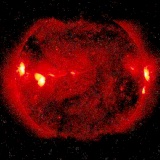 The polar coronal holes are visible in this X-ray image taken by the Yohkoh spacecraft. |
||
| The lower speed solar wind, travelling at about 400 kilometres per second, comes from lower latitudes in the corona. | ||
| The structure of the outflowing solar wind is further complicated by the Sun's rotation. This generates a spiral structure in the solar wind - the solar wind plasma does not travel into interplanetary space in a straight line. | ||
| Impact | ||
| The solar wind travels across the Solar System, and streams across every planet, moon, and small body in its path. The effect the wind has at each body depends on whether or not the body has a magnetic field. | ||
| At Mercury, which has a weak magnetic field, the solar wind plasma does not reach the planet's surface. Venus too has a very weak magnetic field, insufficient to act as a barrier against the plasma, but it does posses a very deep and dense atmosphere which forms a barrier instead. Nevertheless, the upper layer of Venus' atmosphere does lose mass - atoms are picked up by the solar wind and dragged away from the planet. Earth's magnetic field is strong enough to shield the surface. Trapped plasma particles spiral down towards Earth's polar regions thereby generating auroral displays. | ||
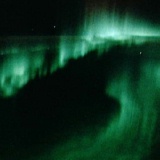 A green-phase Aurora Australis viewed from the space shuttle. |
||
| The Moon, however, lacks both a protective atmosphere and a magnetic field. The energetic plasma particles bombard the Moon's surface, and have been doing so for thousands of millions of years. The plasma particles become incorporated into lunar surface material, and rock samples returned by the Apollo astronauts contain an excess of a helium isotope that is attributed to the solar wind. The Moon is only temporarily shielded once a month when its orbit takes it into Earth's magnetotail. | ||
| The Martian magnetic field is weaker than Earth's, but strong enough to form a magnetosphere. The solar wind therefore flows around Mars rather than impacting the surface. The atmosphere also acts as a barrier, but in this case, the rate of loss of atmospheric atoms stripped off by the solar wind is significant, and over the lifetime of Mars could well have had a significant effect on Mars' evolution. Travelling beyond Mars, the solar wind maintains its speed and power as it blows through the asteroid belt. The majority of asteroids are not shielded at all, and consequently the asteroid surfaces are bombarded by plasma. However, Gaspra and Ida may have weak magnetic fields that allow them to generate a protective magnetosphere. | ||
| The magnetic field of Jupiter is the most powerful planetary magnetic field, and aurorae caused by trapped plasma particles can be seen with the Hubble Space Telescope. The situation at Jupiter is complicated by the electrical flow between Io and Jupiter. | ||
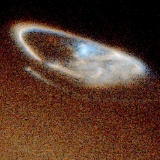 Hubble Space Telescope false-colour image of Jupiter's northern auroral display. |
||
| Saturn too has a strong magnetic field, and, like Jupiter, auroral displays are generated in the polar regions by the solar wind as it passes through the Saturnian system. | ||
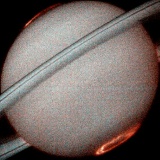 Hubble Space Telescope ultraviolet image of Saturn's polar aurorae. |
||
| As with Venus and Mars, the upper layers of the atmosphere of Saturn's moon Titan are also stripped off and depleted by the solar wind. Titan's situation is unusual, in that Saturn's magnetotail appears to surround the small moon. The solar wind still manages to remove about 0.5 kilogrammes of gas per second, though. | ||
 The upper layers of Titan's atmosphere are stripped off by the solar wind. |
||
| At Uranus, the situation is unusual, as Uranus is tipped on its side and the solar wind first meets the planet's polar regions. Uranus' magnetic field is powerful enough to shield the planet from the solar wind. Within the magnetosphere however there is a lack of heavier ionised atoms. This implies that the solar wind is failing to impact the small moons significantly, as water atoms are not being knocked off the ice surfaces. | ||
| Uranus takes about 84 years to complete one orbit of the Sun, and therefore the solar wind interaction with the planet will change over coming years. At the moment, the planet's pole is pointed towards the Sun and is face-on into the solar wind. As the planet slowly orbits it will be the equatorial regions that first meet the wind. | ||
| Neptune has quite a complicated reaction with the solar wind, and there are several models that attempt to explain the solar wind flow. The tilt of Neptune's magnetic field, coupled with the planet's rotation, causes a severe wobbling of the magnetosphere and magnetotail, with the situation changing over a 16 hour period. Neptune's largest moon, Triton, loses atmospheric mass to the solar wind. It is estimated that Triton loses 0.2 kilogrammes of nitrogen per second, as ionised nitrogen atoms have been detected within Neptune's magnetosphere. | ||
| As no spacecraft have visited Pluto, the situation is uncertain. No magnetic field has been detected. Should Pluto possess a magnetic field, it will be a very weak one and most likely affording no protection from the solar wind. The same applies to Pluto's moon Charon. | ||
| Comets | ||
| The solar wind is invisible, and apart from auroral displays, offers few visible clues to its existence. Nevertheless, the solar wind is powerful, energetic, and streams through the Solar System at greater than hurricane speeds. The greatest visible effect occurs when the solar wind meets a cometary nucleus. As the nucleus is warmed by the Sun, surface evaporation take place, producing a very thin atmosphere. The lack of a cometary magnetic field allows the solar wind to pick up the atmosphere and rip it from the nucleus. The resultant tail of gas and ions extends millions of kilometres, and must have struck fear into the peoples of ancient civilisations. | ||
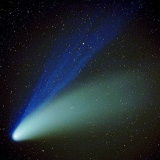 Hale-Bopp quickly developed an impressive double tail. |
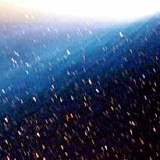 Close-up view of Hale-Bopp's ion tail, caught and extended by the solar wind. |
|
| The heliopause | ||
| Having travelled through the vast distances of the Solar System, the solar wind does not stop, but continues to travel into inter-stellar space. At some point, the wind meets the inter-stellar medium (ISM), and this region is the heliopause. The volume within the heliopause is the heliosphere. The heliopause is estimated to be over 16,400 million kilometres from the Sun, nearly three times the distance to Pluto. | ||
| The heliopause has yet to be detected and its position confirmed. The two Voyager spacecraft are still travelling towards the heliopause, but there is some doubt as to whether or not the spacecraft instrumentation is sensitive enough to detect it. The interaction between the solar wind and the ISM is expected to generate radio energy. Severe solar activity has resulted in radio waves from deep space being detected 400 days later by the Voyagers. The source of the radio energy could be pulses of solar wind plasma meeting the ISM. | ||
|
|
||